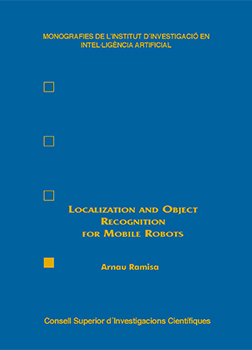
Subjects 
- Archaeology and Prehistory (161)
- Arts and Architecture (240)
- Earth Sciences (95)
- History and Historiography (302)
- History of Science (101)
- Information and Library Sciences (80)
- Life Sciences (170)
- Linguistics and Philology (100)
- Literature and Literary Criticism (133)
- Philosophy and Religion (110)
- Popular Science (257)
- Science and Technology (145)
- Social Sciences (152)
Collections 
Authors 
Send a friend 
Localization and Object Recognition for Mobile Robots
  Arnau Ramisa Affiliation: Consejo Superior de Investigaciones Científicas. Institut d’Investigació en Intel·ligèncía Artificial (Bellaterra, España) Biography: Not available |
Publication year: 2010 Language: English Subjects: Science and Technology Collection: Monografies de l'Institut d'Investigació en Intel-ligencia Artificial Free eBook |
Abstract:
Endowing robots with reasoning capabilities allowing them not to just answer the question “where am I?" but also giving them the ability to infer, for example, the type of room they are in, through semantic recognition of the objects, persons,... in the room, is an extremely dificult research goal. Arnau Ramisa, in this PhD thesis, has addressed these issues and the results he has obtained are a step towards this goal. The thesis has two parts. The first one addresses the localization problem and the second one addresses the object recognition problem. The main contribution of the first part is the obtention of a signature to characterize places relying on a constellation of combinations of diferent types of visual feature regions extracted from a panoramic image of the place that is represented by a node of a topological map graph. The proposed method has been tested with panoramic images of different rooms in various UAB Campus buildings. The results show that through the signature obtained the robot can compute its location even if some changes in the environment have occurred. The second contribution of the first part of this thesis is the development of a biologically-inspired and computationally cheap homing method based on the Average Landmark Vector (ALV). Normally, artificial landmarks had been used together with the Average Landmark Vector, but this thesis introduces a method that combines the ALV with the feature regions used for global localization extracted from the panoramic images mentioned above. Although the localization method proposed in this first part of the thesis is able to reliably model and recognize places, a powerful space representation constructed from semantically rich elements is needed. To progress towards this goal, the second part of this thesis presents and evaluation of two state of the art object recognition methods - SIFT and Vocabulary Tree - and, more importantly, several improvements of these methods are proposed in order to adapt them to the more strict computational requirements of mobile robots. Furthermore, since the evaluation has shown that the suitability of an object recognition method depends on some specific properties of the acquired images, a Reinforcement Learning based approach has been proposed to select, on-line, which object recognition method should be applied in each situation. This learning approach constitutes the last contribution of this thesis.
Bibliographic information
Physical Description : XIV, 141 p. : gráf. ; 24 cm
ISBN: 978-84-00-09150-7
Publication: Bellaterra (España) : Consejo Superior de Investigaciones Científicas, 2010
Reference CSIC: 11902
Other data: Thesis. Universidad Autónoma de Barcelona (Spain), 2009
Buy the digital edition atThis eBook is available for free download |
Free Downloads |
This book was added to our online catalog on Monday 27 October, 2014.







